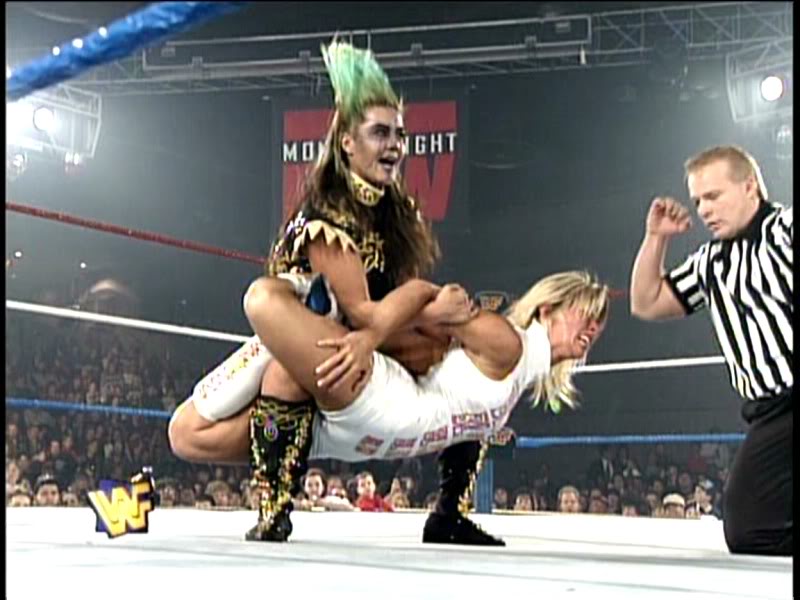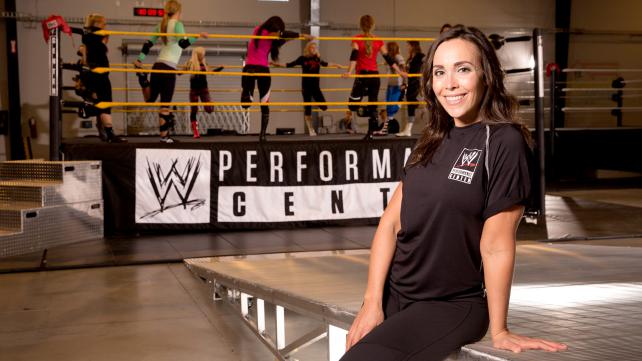
Kana humiliates Arisa Nakajima. (Source)
Pro wrestling is a weird bastard art, and if you’re unfamiliar with its intricacies, the hordes of people in your social media circles obsessively pontificating about it every Monday night must be a truly confounding experience. Let our very own Dominic Griffin, lifelong wrestling enthusiast, teach you a little something right here, In This Very Ring…
From the perspective of passive spectators, when someone asks you to picture a female wrestler, I’m pretty sure your first image is going to be something out of a Bra and Panties match. Vince McMahon’s vision for women in wrestling has long been from a pretty blunt “sex sells” stance. Throughout the late 90s, he and his creative team found a way to take a roster full of talented performers and contort them into situations that required them to be glorified bikini models. Later, this practice would give way to saying “fuck the middleman” and just straight up hiring bikini models and teaching them the basics of how to wrestle. As such, the mainstream expectation when seeing a woman on wrestling television is that she is either there for titillation, as an accessory to her male counterparts, or merely as a crude shorthand for a restroom break.
That obviously isn’t how it needs to be, though. I’m not going to hearken back to the early days of female wrestling, because no matter how many old Fabulous Moolah matches I watch, it’s not something I have a strong connection to. For me, my understanding of the way women wrestling should be comes from two women: Alundra Blayze & Bull Nakano.

Bull Nakano with Alundra Blayze locked into the Scorpion Cross-Lock. (Source)
Blayze used to wrestle around the world as Madusa, but was transformed into a Wonder Woman-esque superheroine in Vince’s world. Naturally, she needed a supervillain, so he brought in Nakano from Japan, one of the country’s most accomplished joshi (Japanese female wrestlers.) As a kid, the first pay-per-view I ever watched live was Summerslam ’94, and Blayze/Nakano was one of the best matches on the card. Nothing about their match was treated differently than any of the men’s matches. It was tough, technical, hard-hitting and exciting.
Cut to like five years later. The Attitude Era is in full swing. I still get to see women’s wrestling matches, but even the bigger feuds, like Sable vs Jacqueline, were satellites orbiting around a male centerpiece (in this case Sable’s ex Marc Mero) and predicated by literal bikini contests. Now, being 13, this was great. The only thing I wanted to see more than colorful characters beating the shit out of each other was some boobs, and Vince McMahon knew his audience. Making women onscreen explicit objects irreparably broke women’s wrestling in the mainstream.
The tide had turned from Blayze and Nakano to overtly sexual valets like Tammy “Sunny” Sytch, whose on screen persona was that of a Jerry Springer harlot who manipulated the various tag teams she managed and followed wherever the championships went.
If you still wanted to see Blayze and Nakano, you could catch them on WCW Nitro, following in the proud WCW tradition of rehashing something successful from their competition a few years too late to capture the zeitgeist. Blayze was one of the many who signed with Ted Turner and Eric Bischoff’s infinite money train, famously taking the WWF Women’s Championship with her onto WCW television and throwing it into the trash.
Given historical context, it may have been more of a feminist protest from Blayze than merely a shot in the nascent Monday Night Wars.
Over time, this trend continued. The “Women’s Championship” gave way to the “Divas Championship” as female wrestlers were branded Divas, sort of as a counterpart to male wrestlers all being called Superstars. (Yes, in the WWE everyone is a Superstar, even the guys who never win. It’s like porn.) There was a nice period during the early 2000s that’s a little hazy for me when women like Trish Stratus, Lita, and others were getting the opportunity to have fully fledged characters and wrestle pretty good matches. It felt like a real division and not just a sexual diversion in between the “real” wrestling. There were still sleazy gimmick matches and the like, but this era’s stars were at least given solid time in the ring and the opportunity to show they were more than just tits and ass.
The problem, of course, is that they have to prove it at all. Women’s wrestling in the mainstream is always a special annex. The few times a woman got to run with the boys, it was executed strangely. Chyna’s Intercontinental Title reign and feud with male wrestlers was cool and all, but it’s no coincidence that the first woman given the chance to tussle with the men is the one most regularly ridiculed for being masculine in appearance.
Around 2004/2005, I started getting really into indie wrestling, starting with Ring of Honor. Somewhere around this time I started seeing women wrestling that reminds me of the good old days. I started to discover Sara Del Rey, Awesome Kong, and others. Women who are more concerned with kicking ass than getting Maxim spreads. This led to me watching more Joshi stuff on YouTube, old classics from Manami Toyota and Aja Kong. A few years ago, I discovered the all-female promotion Shimmer, which provided a wealth of variety in terms of women’s wrestling, as their ever-changing roster included a lot of indie darlings as well as international sensations, an entire enterprise created to give the hungry public some amazing dream matches.
One such dream match was when they brought Joshi thriller Kana to the states to battle the Queen of Wrestling, the aforementioned Del Rey, at Shimmer Vol. 42. Here’s a taste:
That, to me, is what I was missing. In Shimmer, women are given the freedom to develop their own characters and be themselves. They don’t have to be swimsuit models, but they also don’t have to dowdy themselves down and be anti-glam tomboys. The promotion offers a variety of character types, and women of all backgrounds and frames are represented, from the scrappy, smaller frame of a Portia Perez, the matronly veteran build of Saraya Knight, or the more curvaceous build of a Jessicka Havok. It may not be the main goal, but having sincere body positivity as a byproduct of your wrestling program is a step in the right direction.[1]
The other problem in WWE, outside of the overt sexualization of women’s wrestling, is the manner in which the product is presented. Because they’re only given a couple of minutes of in-ring screen time, the current crop of Divas have considerably less practical space to hone and perfect their craft. They’re treated like halftime distractions, as much a visual cue to take a bathroom break or grab a beer as anything else. On the off chance they do get a pay-per-view match that runs ten minutes and ends up sloppily executed, people just assume the performers themselves suck, and not the manner in which they are booked. They’re practically set up to fail.
Divas aren’t given traditional heel/face alignment, as they can be quickly and without context switched from one side or the other based on the needs of a match or angle. It’s impossible for these women to develop long term characters or connections with fans if they are treated as random cyphers or interchangeable. Most of them aren’t even given last names anymore! The extent of what a woman is allowed to be in the WWE is very limited. Your character options are “fucking crazy” like AJ Lee (one of the best Divas in years) as was regularly portrayed, and as relative veteran Alicia Fox is currently characterized, her gimmick little more than throwing tantrums after matches and throwing shit at people[2]. You can be someone’s mouthpiece, like the “Ravishing Russian” Lana, who currently represents Soviet baddie Rusev. You also have the opportunity to be a secondary WWE character whose entire existence is connected to one of the men on the roster, like Summer Rae, who is trapped in an “ex girlfriend” angle with the dancing Fandango (which, if we’re being technical, also falls under the “crazy” header).

Sara Del Rey, the fucking queen. *Beyonce’s “***Flawless” plays* (Source)
It’s pretty tragic. Luckily, some things are changing. A little. WWE hired Sara Del Rey (real name Sara Amato) as their head Diva trainer down at the Performance Center. As a result, NXT, WWE’s developmental brand, currently is producing some of the best women’s wrestling in North America. The new generation of Divas that are being brought up under Amato’s tutelage are crafting some strong characters, and on NXT they’re being given the time and spotlight to create some great matches. Emma and Paige’s Women’s Title[3] match from NXT’s ArRival event was amazing, not just because of the in ring skill on display, but because everyone from the production crew to the announce team treated it like it was a real thing. No one was cackling wildly about how “nutty these dames are” or screaming “puppies!” every time a breast jiggled during an arm drag. Bailey (an optimistic babyface determined to make friends who represents the #HugLife), Sasha Banks (The BOSS) and Charlotte (legend Ric Flair’s extremely gifted daughter) are proving that the future for women in the WWE doesn’t have to be a carnival side show. It can be the main attraction.
Unfortunately, as some of these performers are called up to the main roster, the same old plagues are poisoning their potential. Just ask Emma. On NXT, she was an infectious personality known for her horrible excuse for dancing that became pretty adorable over time, while maintaining a selfish, apathetic personality. It was a pretty layered wrestling character, and the dance is a lot of fun, but on Raw, she is now the sidekick and quasi-girlfriend of comedy wrestler Santino Marella, and everything she does is treated like it’s a bad joke.
The key to this problem should be obvious, based on nothing than the sheer number of times I’ve had to use the qualifier “women’s wrestling.” Just package it as wrestling. I leave you with one of my personal favorite examples of what I mean: Kana and Serena Deeb (former WWE talent) in the now defunct Japanese promotion SMASH. This is just a brief teaser of a larger feud, and in Japanese, but you will still get a basic understanding of what is at stake. Exciting characters, engrossing storylines, hard-hitting matches. That’s all it takes. It’s just wrestling.
[1] It should also be noted that in TNA wrestling, a promotion whose very fucking name is a not so clever play on “tits n’ ass,” actually has cultivated a solid women’s division over the years, with a roster deep enough to support women’s tag teams as well as pretty good solo rivalries. Women like Mickie James, who in the WWE was embroiled in a storyline where she was called “Piggie James” because of her moderate size differential over her competitors, are welcomed with open arms. Now, they still wrestle in booty shorts, so whether or not there is real progressive thought at play in talent development, or if the proud Southern tradition of ‘rasslin’ TNA was born of simply espouses a love of “thicker” ladies the same way Vince fetishizes swimsuit models and body builders is another matter entirely.
[2] To be fair, she is really fucking good at it.
[3] That’s right. Women’s title. Not the fucking Lisa Frank Invitational Championship.
Follow @DeadshirtDotNet and @captain_fuck on Twitter where we’ll be available to answer any possible question you could have about wrestling.

